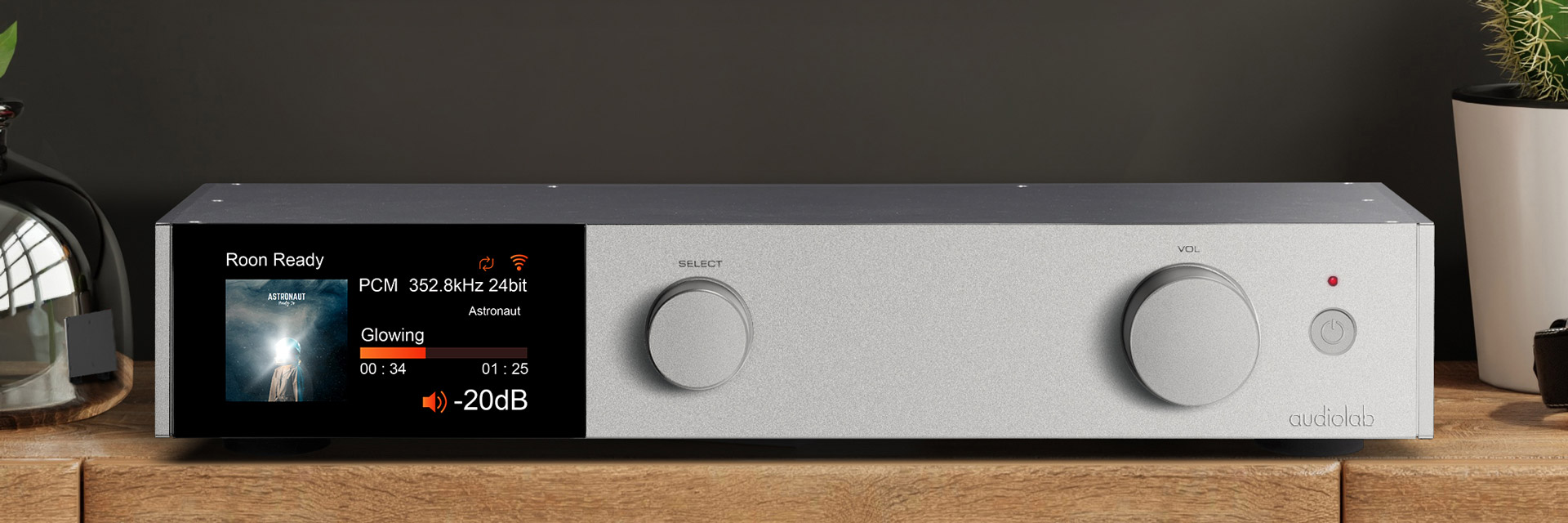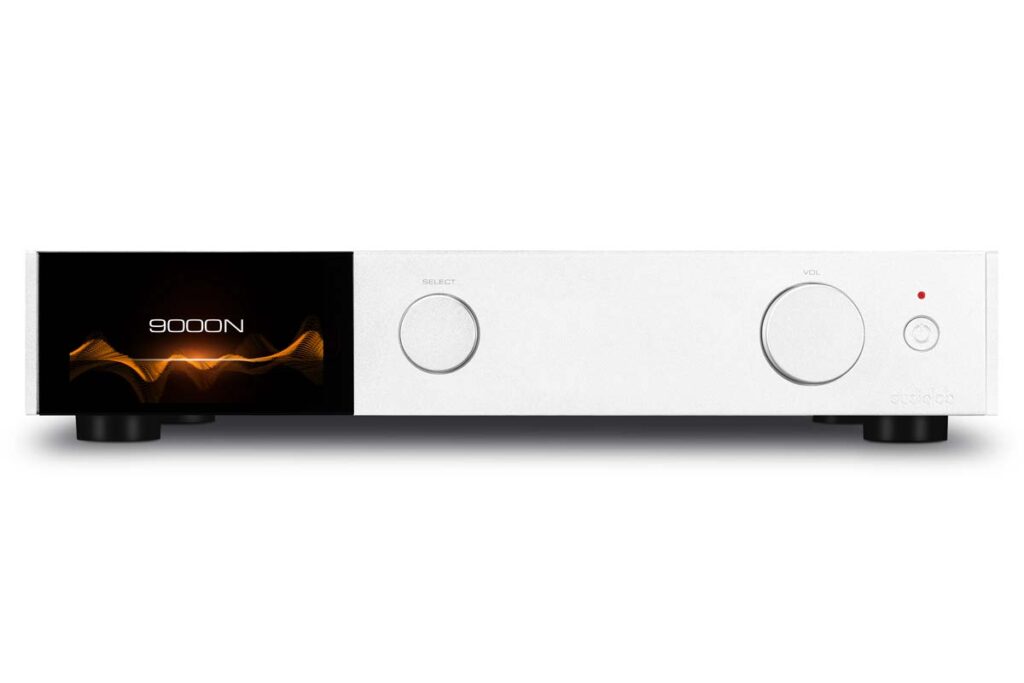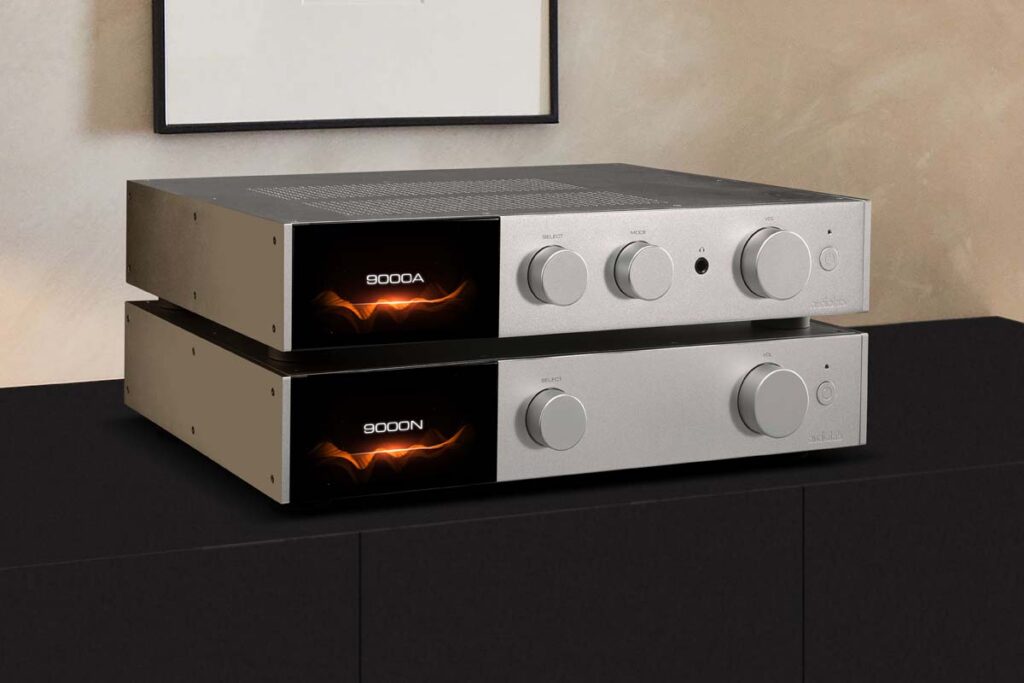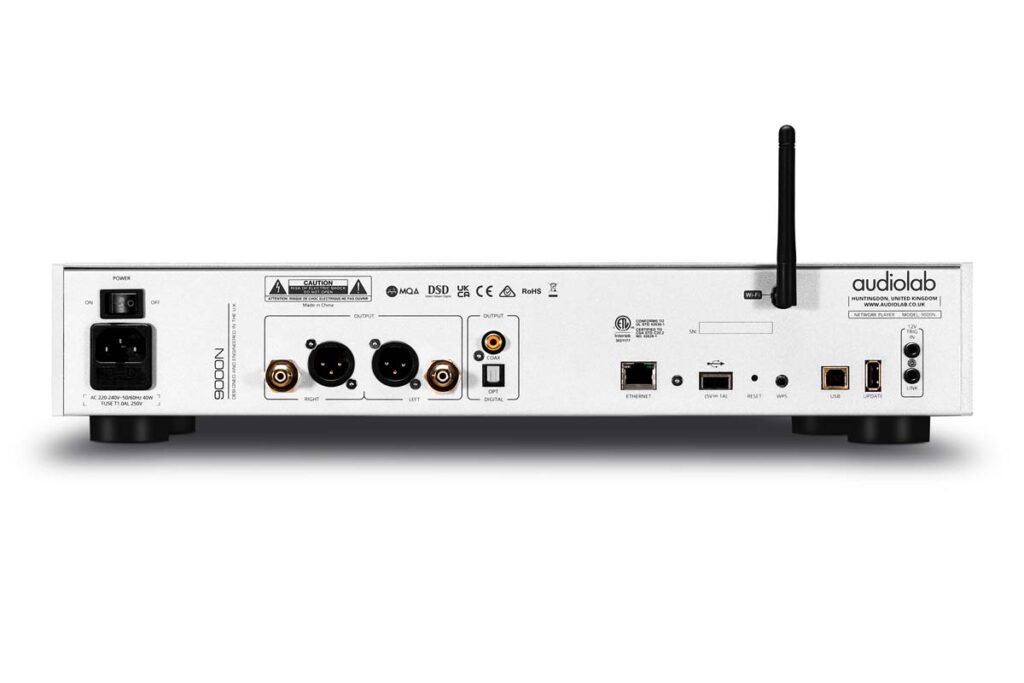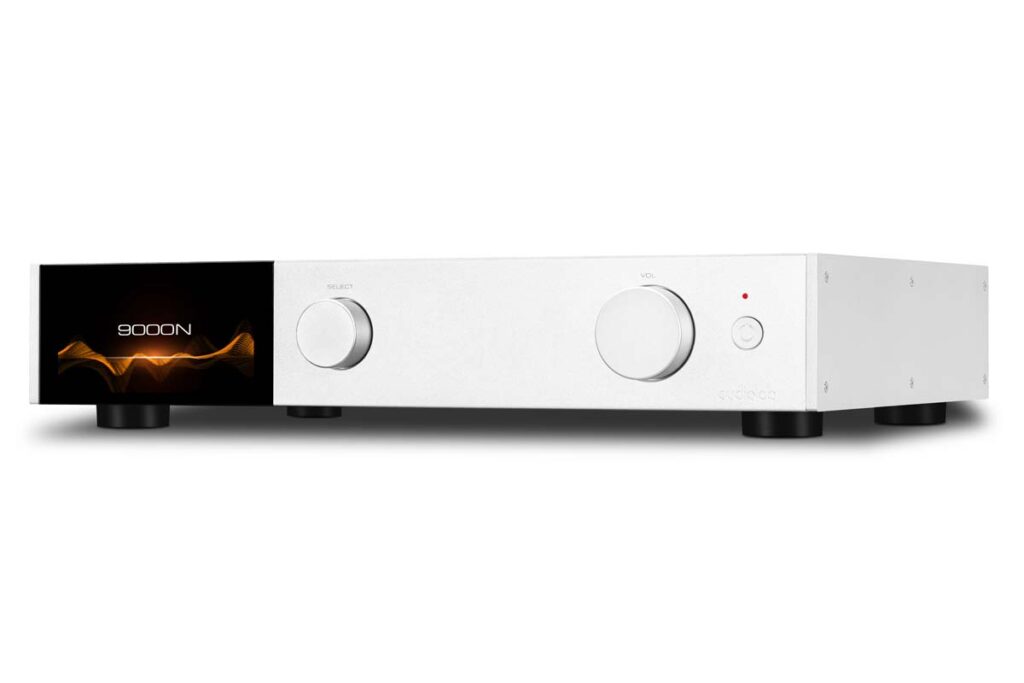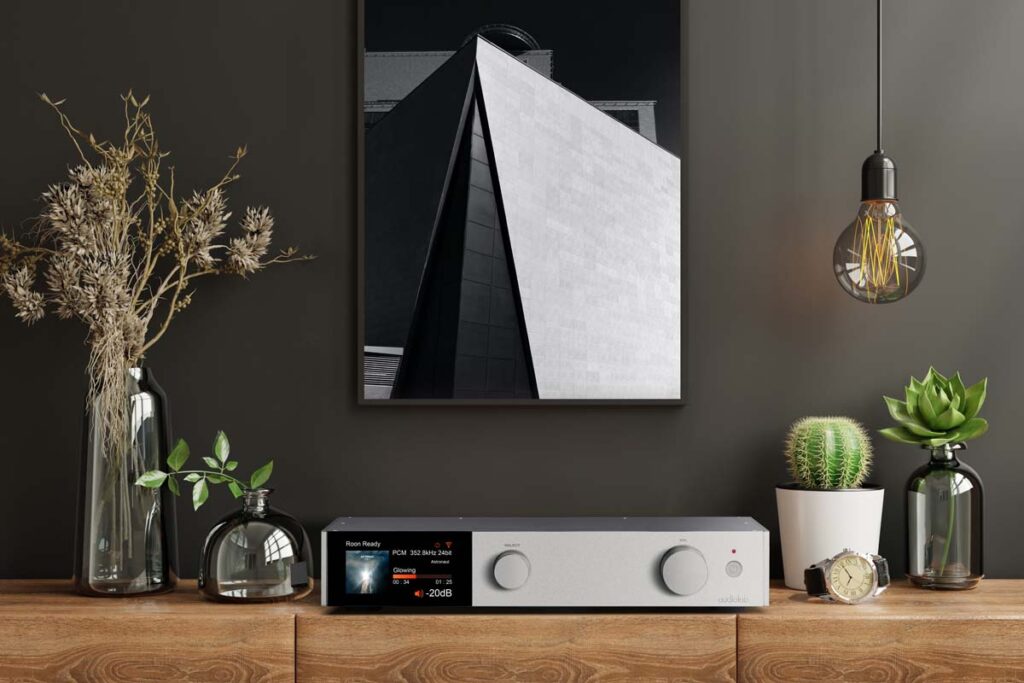The 9000 series from British brand Audiolab now has a streamer. So far, so mundane. But what you’ll find under the sturdy and shiny chic housing is a circuit from one of the alpha wolves of the streaming guild.
The streaming technology for the Audiolab 9000N comes from Lumin, and they have known for some time how to play music on the network and from the Internet. A total of around three years of development work (and new layouts due to chip shortages) went into the device, and there were a total of five versions before the final series device was good enough for the Audiolab team led by chief developer Jan Ertner to release. The top streamer thus breaks new (more accessible) ground not only in terms of sound, but also in terms of operation.
Setting up the Audiolab network player is child’s play thanks to the app tailored to the 9000N. Using the WPS button, the device connects to your router without any control program. Operation is also logical in other respects. Two rotary encoders with a push function allow you to configure the streamer and control the output volume, while the included remote control (in black for the silver housing version) provides quick access to the playback functions so that operation is smooth even without an app. Music should be selected from the respective streaming service using the small program on your own smartphone. Although it says “Audiolab” on the app, it is undoubtedly a customized Lumin app. This sets the British brand’s top-of-the-range model apart from the smaller streamers from the company, which rely on Play-Fi control. Although this also works quite well, it was never really convenient. The native integration of my Qobuz access on the large 9000N is very straightforward via my smartphone. Am I already in? Yes, and I can start right away.
First of all, the musically powerful amplifier from the same series, the 9000A, is connected to the balanced analog output. When connected to the Klipsch Heresy IV, the new record by jazz musician Torsten Goods (Soul Searching) immediately opens up a wide-ranging stage with clearly defined bass reproduction and a finely resolved high-frequency range that never gets too loud. Pete York, drummer of the Spencer Davis Group, can be heard as a guest on the grooving new recording of “Keep On Running”. The British musician’s voice sounds authentically aged and yet always with a mischievous smile, for example when he muses with Goods about whether this might not become a number one again … The 9000N delivers a thoroughly big sound image via its analog outputs. I noticed minimal differences between the unbalanced and balanced outputs. The latter comes with a little more thrust from the lowest frequencies.
The housing made of screwed, very solid aluminum plates looks high quality, even if I personally think the slightly pearly shiny finish is too much of a good thing, but that’s a matter of taste. What the new streamer has in common with older Audiolab devices is the origin of the converter chip. Once again, it comes from the ESS Sabre converter series. Specifically, this is an ESS Sabre ES9038Pro 32-bit DAC (PCM and DSD). The integrated anti-jitter circuit reduces the already low distortion. The eight-channel converter is fully utilized with four units each for the left and right channels. This further reduces the signal-to-noise ratio.
An ARM Cortex A53 is used to manage the playback processes, and this processor is a reliable industry standard. In fact, I had no crashes or problems during normal gaming. Speaking of playing: the very easy-to-read 4.3-inch color display provides me with all the information about the music being played and also guides me through the settings, such as the selection of the five output filters for individual sound adjustment. Knowing that my old Audiolab chain has been around for many years, it is clear to me that the developers in Huntingdon have gained a great deal of experience with the converters in this series. And you can hear this in the careful, musical tuning of the device. This is also due to the power supply and the Class A analog section. A 50 VA Noratel toroidal transformer feeds the total of 18 internal power supplies. Even the left and right channels of the DAC each have their own supply line.
Bruce Soord’s sonically outstanding album Luminescence begins. The acoustic guitar fills the deeply illuminated echo chamber before electronically generated rhythm elements together with Soord’s gentle voice introduce the catchy “Dear Life”. Through the Audiolab amplifier, this has a warm, open basic orientation. Spatial details of the production are clearly comprehensible to me, the length of the reverb tail doesn’t hide anything and is still allowed to fade out without artifacts. I switch to my Luxman tube via unbalanced wiring, and the same piece sounds at a similarly high level as through the Audiolab 9000A amplifier. But now the sound image opens up even more in the treble range, the transients of the acoustic guitar are more clearly defined and the reverb tail described above is even more distinct from the direct sound of the instruments. The 9000N network player delivers an incredibly coherent performance in this combination. The balance between speed, dynamics, foundation and broadband is at a very high level. Here, the streamer shows off its capabilities even more fully on my carefully assembled chain than on the equally good amplifier from my own company. This means that the 9000 family is already very coherent in itself, but the streamer itself can deliver even more musical details in combination with even higher-quality components, which more than justify the price, especially as original Lumin technology is actually handling the streaming data under the hood – an ingenious move by the developers, and this actually makes the 9000N a wolf in admittedly chic sheep’s clothing, to use this somewhat hackneyed but understandable image.
In addition to the integration of Qobuz, Tidal, TuneIn radio and Spotify are also served natively and MQA files are decoded. The 9000N also cuts a very good musical figure as an Airplay 2 receiver, but of course also shows the somewhat rounder basic sound of the Apple transmission protocol. In addition to the wireless and wired reception of music data from streaming and UPnP sources, digital audio can be fed in from a PC via USB. There are no other digital inputs. However, in addition to the balanced and unbalanced outputs, there is a coaxial and an optical digital output should the sound quality of the ESS Sabre ES9038Pro not be sufficient as a converter. (By the way, in the world of social media there would be an emoji with hands folded over its head at this point, you get what I mean).
In addition to a high-resolution representation of the record cover, the display also shows me information about the incoming data format, digital resolution, title, artist, playing time and volume of the adjustable output – I can read it from the comfort of my listening position. Of course, the contents of the display can be selected by the user, right up to switching off the display.
The sound characteristics of the 9000N described above are demonstrated with a jazz album such as Leroy Walks! by the Leroy Vinnegar Sextet. The instruments of this 1958 recording, which were still heavily distributed to the right and left in the stereo spectrum, nevertheless convey the feeling of sitting together with the musicians in a wood-paneled club. The vibraphone sounds with bell-like substance from the left speaker, while Leroy Vinnegar’s bass peels out of the right speaker with a fine swing. No bigger than the original, but with a natural body and clear tonal clarity. The Audiolab once again decodes the high-resolution recording in 192 kilohertz and 24 bit in a balanced musical way with good dynamics and space between the instruments. This makes HiRes really fun!
With simple user guidance, ultra-solid workmanship, an informative and beautiful display and, of course, great, detailed sound, the latest addition to the 9000 family scores plenty of points and is, in my opinion, the best device in Audiolab’s top line to date.
STATE OF THE ART
The Lumin know-how in the 9000N offers native integration of Spotify Connect and Tidal Connect so that music can be played directly from the respective streaming applications. If you work with UPnP/DLNA apps such as mconnect or BubbleUPnP, you can also address the Audiolab directly with these. The streamer can of course be integrated into an existing Roon system. With regard to MQA, the 9000N is able to play as a pure MQA renderer and then pass on all digitally available information from Tidal’s HiFi Plus subscription unfiltered to an external MQA DAC in passthrough mode. The internal MQA capabilities run at the highest specification, i.e. 384 kilohertz sampling frequency and the use of all decodable levels of the special format.
Accompanying Equipment
CD player/converter: Luxman D-N150 | Streamer: Volumio | Preamplifier: Audiolab 8200 CDQ | Integrated amplifier: Luxman SQ-N150 | Power amplifier: Audiolab 8200 P | Speakers: Klipsch Heresy IV | Cables: Ecosse, Tara Labs, Furutech, Supra, Graham Slee
Network player Audiolab 9000N
Concept: network player with MQA decoding, Tidal Connect and Spotify Connect | Special features: adjustable or fixed output volume, NativeDSD up to DSD 512, clearly arranged and customizable 4.3-inch colour display, sophisticated power supply, remote control, easy-to-understand operating instructions in German | Inputs: Network (WiFi and Ethernet), USB-B input, USB-A port for external storage media | Analog outputs: 1 x balanced XLR, 1 x unbalanced RCA | Digital outputs: S/PDIF optical and coaxial | Color: Black, silver | Dimensions (W/H/D): 44/9/33 cm | Weight: 6.2 kg | Warranty period: 2 years | Price: around €2790
IAD
Johann-Georg-Halske-Straße 11
41352 Korschenbroich
Phone +49 2161 617830
info@iad-gmbh.de

